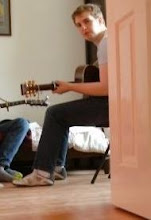George Harrison's Wonderwall music is perhaps the most interesting concept album I've ever heard. Recorded partially in 1967 in England and then partially in 1968, during the Beatles' trip to India and released on the Beatles' own label Apple. When I first found it I was amazed by the sound of the thing, the Opening track 'Microbes' is awash with Sitar drones and as the album progresses the styles move through Russian folk music mixed with traditional Indian Sitar & Tabla music to farcical movements of music inspired by Cowboy movie soundtracks complete with Tack piano.

Harrison probably more so than the other Beatles' embraced Indian music, above he's being taught to play by Ravi Shankar, a Sitar maestro, Indian classical music played a large part in the later Beatles albums and Harrison can be credited bringing the Sitar and other Indian instruments into western music.
Wonderwall Music is a concept album made up of mostly instrumental tracks, some of it verging on what might be classed as Psychedelia, but I'd say the album touches upon more musical bases than 'Revolver' or 'Sgt. Pepper' did. Many of the familiar techniques from the Beatles' albums can be heard such as the reverse Guitar & Sitar solos.
However the album isn't all Indian music, 'Party Seacombe' is quintessential Revolver era Beatles all it's lacking it John or Paul's vocal line. In fact the only track with any vocals on is 'Dream Scene' which features an Male/Female duet sung by Indian singers.
The album reaches its "conceptual" peak on the 1.16 minute track 'Crying' as a screeching drone begins, that sounds a lot like crying, but it abates into a melancholy melody. This, probably the least 'mainstream' track of the whole album, gives way to 'Cowboy Music' a plodding homage to Cowboy movie soundtracks complete with Harmonica and Lap steel guitar.
'On the Bed' features Flugelhorn over a piano drenched in a chorus effect, while a weaving guitar solo is played over the top of it, as the drums swell in the mix and push the song along.
The album ends solemnly with 'singing omm' which is exactly what it does over a droning Harmonium and a beautiful melody line from a Flute.
This was Harrison's debut album, not exactly a mainstream offering, but then again I don't think Harrison was trying to get in the Charts. (It actually reached #49 in the USA in 1969, the height of the Psychedelic era.) I think this concept album is a testament to a musician who made the music he wanted to make. That's maybe what impressed me most when I first heard it, I realised that you could make whatever music you wanted, as long as you liked it. Listening to this album opened up me up musically, I hadn't heard Indian music at all before and hearing a Sitar for the first time amazed me. It was the catalyst for a major interest in Classical Indian music but I hadn't listened to this album in over a year until today. I don't know what made me put it on but I'm glad I did and I thought I'd tell you about it.
I've embedded some links in the titles of some of the tracks I mentioned but here is one track I didn't mention called 'Gat Kirwani'.
- "Microbes" – 3:42
- "Red Lady Too" – 1:56
- "Tabla and Pakavaj" – 1:05
- "In the Park" – 4:08
- "Drilling a Home" – 3:08
- "Guru Vandana" – 1:05
- "Greasy Legs" – 1:28
- "Ski-ing" – 1:50
- "Gat Kirwani" – 1:15
- "Dream Scene" – 5:26
- "Party Seacombe" – 4:34
- "Love Scene" – 4:17
- "Crying" – 1:15
- "Cowboy Music" – 1:29
- "Fantasy Sequins" – 1:50
- "On the Bed" – 1:05
- "Glass Box" – 2:22
- "Wonderwall to Be Here" – 1:25
- "Singing Om" – 1:54



* Musician
ReplyDeletethanks
ReplyDelete